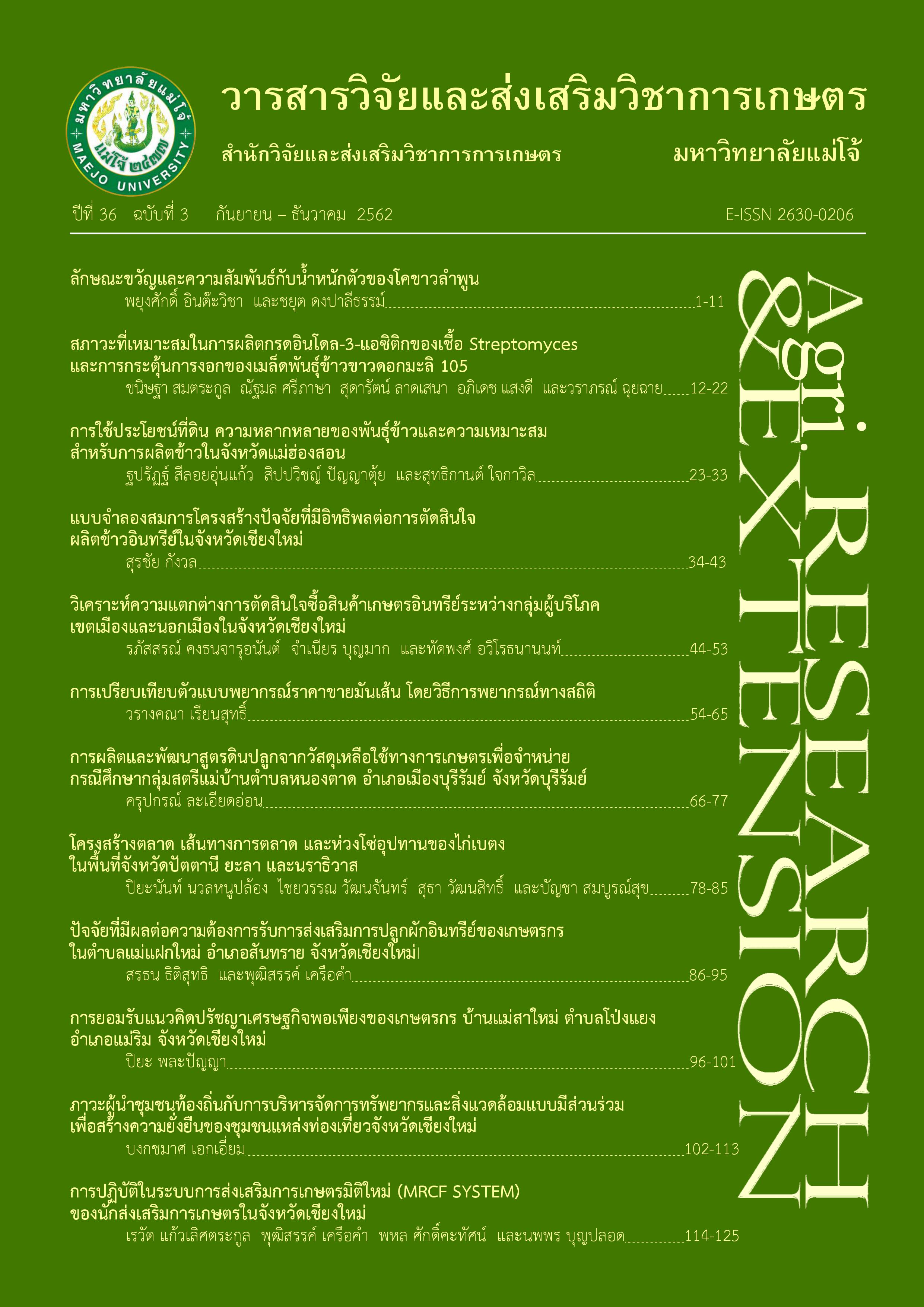สภาวะที่เหมาะสมในการผลิตกรดอินโดล-3-แอซิติกของเชื้อ Streptomyces และการกระตุ้นการงอกของเมล็ดพันธุ์ข้าวขาวดอกมะลิ 105
คำสำคัญ:
กรดอินโดล-3-แอซิติก, ข้าวขาวดอกมะลิ 105, สเตรบโตมัยซีสบทคัดย่อ
การศึกษาจัดทำขึ้นเพื่อทดสอบผลของอุณหภูมิ pH และโซเดียมคลอไรด์ ต่อการผลิตกรดอินโดล-3- แอซิติกโดยแบคทีเรีย 4 ชนิดที่คัดแยกได้จากปุ๋ยมูลไส้เดือน ได้แก่ Streptomyces sp. SEF4, Streptomyces sp. SEF11, Streptomyces sp. SEF28 และStreptomyces sp. SEF37 รวมทั้งศึกษาผลของน้ำเลี้ยงเซลล์แบคทีเรียและสารแขวนลอยของแบคทีเรียทั้งสี่ชนิด ต่อการกระตุ้นการงอกและการเจริญเติบโตในระยะต้นกล้าของข้าวขาว ดอกมะลิ 105 ผลการศึกษาพบว่าแบคทีเรียทั้ง 4 สายพันธุ์ผลิตกรดอินโดล-3-แอซิติกได้ดีที่อุณหภูมิ 27-30ºซ. (18.8-20.7 มก./ลิตร) และpHระหว่าง 7-9 โดย Streptomyces sp. SEF4, Streptomyces sp. SEF11 และ Streptomyces sp. SEF28 สามารถผลิตกรดอินโดล-3-แอซิติกได้ดีในสภาวะที่มีโซเดียมคลอไรด์ความเข้มข้นร้อยละ 2.55 อย่างไรก็ตามการใช้สารแขวนลอยของแบคทีเรียไม่มีผลต่อการกระตุ้นการงอกและการเจริญเติบโตในระยะต้นกล้าของข้าวขาวดอกมะลิ 105 ส่วนการใช้น้ำเลี้ยงเซลล์ของ Streptomyces sp. SEF11, Streptomyces sp. SEF28 และ Streptomyces sp. SEF37 มีแนวโน้มช่วยกระตุ้นให้เมล็ดข้าวงอกเร็วขึ้น ในขณะที่น้ำเลี้ยงของ Streptomyces sp. SEF4 และ Streptomyces sp. SEF11 มีแนวโน้มเพิ่มความยาวของยอด แต่น้ำเลี้ยงเซลล์ทุกชนิดทำให้ความยาวรากของต้นกล้าข้าวลดลง อย่างไรก็ตามการที่แบคทีเรียเหล่านี้ผลิตกรดอินโดล-3-แอซิติกได้ในสภาวะที่มีเกลือและเป็นด่างจึงมีโอกาสเป็นไปได้ในการใช้แบคทีเรีย Streptomyces ร่วมกับการปลูกข้าวในภาคตะวันออกเฉียงเหนือในอนาคต
เอกสารอ้างอิง
Abd-Alla, M.H., A. El-Sayed and A.-H. M. Rasmey. 2013. Indole-3-acetic acid (IAA) production by Streptomyces atrovirens isolated from rhizospheric soil in Egypt. Journal of Biology and Earth Sciences. 3: B182-B193.
Ahmad, F., I. Ahmad and M.S. Khan. 2008. Screening of free-living rhizospheric bacteria for their multiple plant growth promoting activities. Microbiol. Res. 163: 178-181.
Alam, M., S. Dharni, A. Khaliq, S.K. Srivastava, A. ad and M.K. Gupta. 2012. A promising strain of Streptomyces sp. with agricultural traits for growth promotion and disease management. Indian J. Exp. Biol. 50: 559-568.
Calvelo Pereira, R.C., C. Monterroso and F. Macias. 2010. Phytotoxicity of hexachlorocyclohexane: Effect on germination and early growth of different plant species. Chemosphere. 79: 326-333.
Chuanren, D., W. Bochu, L. Wanqian, C. Jing, L. Jie, and Z. Huan. 2004. Effect of chemical and physical factors to improve the germination rate of Echinaceae angustifolia seeds. Colloids Surfaces B. 37: 101-105.
Gopalakrishnan, S., V. Srinivas, M.S. Vidya and A. Rathore. 2013. Plant growth-promoting activities of Streptomyces spp. in sorghum and rice. SpringerPlus. 2: 574.
Gopalakrishnan, S., S. Vadlamudi, P. Bandikinda, A. Sathya, R. Vijayabharathi, O. Rupela, H. Kudapa, K. Katta and R.K. Varshney. 2014. Evaluation of Streptomyces strains isolated from herbal Vermicompost for their plant growth-promotion traits in rice. Microbiol. Res. 169: 40-48.
Kaneko, M., H. Itoh, M. Ueguchi-Tanaka, M. Ashikari and M. Matsuoka. 2002. The alph-amylase induction in endosperm during rice seed germination is caused by gibberellin synthesized in epithelium. Plant Physiol. 128: 1264-1270.
Khamna, S., A. Yokota, J.F. Peberdy and F. Lumyong. 2010. Indole-3-acetic acid production by Streptomyces sp. isolated from some Thai medicinal plant rhizosphere soils. EurAsia. J. BioSci. 4: 23-32.
Kukusamude, C. and S. Kongsri. 2018. Elemental and isotopic profiling of Thai jasmine rice (Khao Dawk Mali 105) for discrimination of geographical origins in Thung Kula Rong Hai area, Thailand. Food Control. 91: 357-364.
Li, Z., J. Zhang, Y. Liu, J. Zhao, J. Fu, X. Ren and G. Wang. 2016. Exogenous auxin regulates multi-metabolic network and embryo development, controlling seed secondary dormancy and germination in Nicotiana tabacum L. BMC Plant Biol. 16: 41.
Office of The National Economic and Social Development Board. 2017. Gross domestic product, chain volume measures: Q1/2017. Thailand.
Siriwat, S. and I. Kheoruenromne. 2006. Environmental condition of saline soils distributed in Sakon Nakhon Basin, Northeast Thailand. In Proceedings of 44th Kasetsart University Annual Conference : Plants. 30 January – 2 Febuary, 2006. Bangkok: Kasetsart University.
Sreevidya, M., S. Gopalakrishnan, H. Kudapa and R.K. Varshney. 2016. Exploring plant growth-promotionActinomycetes from vermicompost and rhizosphere soil for yield enhancement in chickpea. Braz. J. Microbiol. 47: 85-95.
Susilowati, D.N., E.I. Riyanti, M. Setyowati and K. Mulya. 2018. Indole-3-acetic acid producing bacteria and its application on the growth of rice. AIP Conference Proceedings 2002: 020016.
Tamreihao, K., D.S. Ningthoujama, S. Nimaichand, E.S. Singh, P. Reena, S.H. Singh and U. Nongthomb. 2016. Biocontrol and plant growth promoting activities of a Streptomyces corchorusii strain UCR3-16 and preparation of powder formulation for application as biofertilizer agents for rice plant. Microbiol. Res. 192: 260-270.
Tanimoto, E. 2005. Regulation of root growth by plant hormones – roles for auxin and gibberellin. Cri. Rev. Plant Sci. 24: 249-265.
Tsavkelova, E.A., S.Y. Klimova, T.A. Cherdyntseva and A.I. Netrusov. 2006. Microbial producers of plant growth stimulators and their practical use: A review. Applied Biochem. Microbiol. 42: 117-126.
Wang, Y., Y. Cui, G. Hu, X. Wang, H. Chen, Q. Shi, J. Xiang, Y. Zhang, D. Zhu and Y. Zhang Y. 2018. Reduced bioactive gibberellin content in rice seeds under low temperature leads to decreased sugar consumption and low seed germination rates. Plant Physiol. Bioch. 133: 1-10.
ดาวน์โหลด
เผยแพร่แล้ว
รูปแบบการอ้างอิง
ฉบับ
ประเภทบทความ
สัญญาอนุญาต

อนุญาตภายใต้เงื่อนไข Creative Commons Attribution-NonCommercial-NoDerivatives 4.0 International License.
บทความนี้ได้รับการเผยแพร่ภายใต้สัญญาอนุญาต Creative Commons Attribution-NonCommercial-NoDerivatives 4.0 International (CC BY-NC-ND 4.0) ซึ่งอนุญาตให้ผู้อื่นสามารถแชร์บทความได้โดยให้เครดิตผู้เขียนและห้ามนำไปใช้เพื่อการค้าหรือดัดแปลง หากต้องการใช้งานซ้ำในลักษณะอื่น ๆ หรือการเผยแพร่ซ้ำ จำเป็นต้องได้รับอนุญาตจากวารสาร





